I did a complete maintenance on the front brakes of my 2013 Polo GT at home. The work involved removing the brake pads, removing the rotors, resurfacing/machining the rotors at a lathe workshop, cleaning the entire assembly, replacing the caliper bolts, rubber caps and guide pins, greasing the relevant parts and reassembling everything back.


Putting up a dedicated, detailed DIY thread to our repository for reference. The front brakes on my Polo are based on the
FN 3 brake system. This is also applicable for the Vento and Rapid. If you wish to service the front brakes at home and have some spare time at disposal, look no further! Ill keep it short and simple.
Tools required: - Floor jack
- Jack stands - 2 nos.
- 1/4" ratchet set
- 18 mm socket or 18-19 ring spanner
- S-type hook/hanger (or make one with a metal shirt hanger)
- C-clamp 150 mm/6
- Wire brush (or a drill with a cup brush attachment)
- Straw cleaning brush
- Waste cotton clothes
- Magnetic screw tray (link on how to make one at home)
- Vernier caliper or screw gauge
Good to know:
My ETKA workshop manual does not specify the torque ratings for the FN 3 256 mm disc brakes. It mentions 256 mm discs for the 14 FS III system and 288 mm discs for the 15 FN3 system:
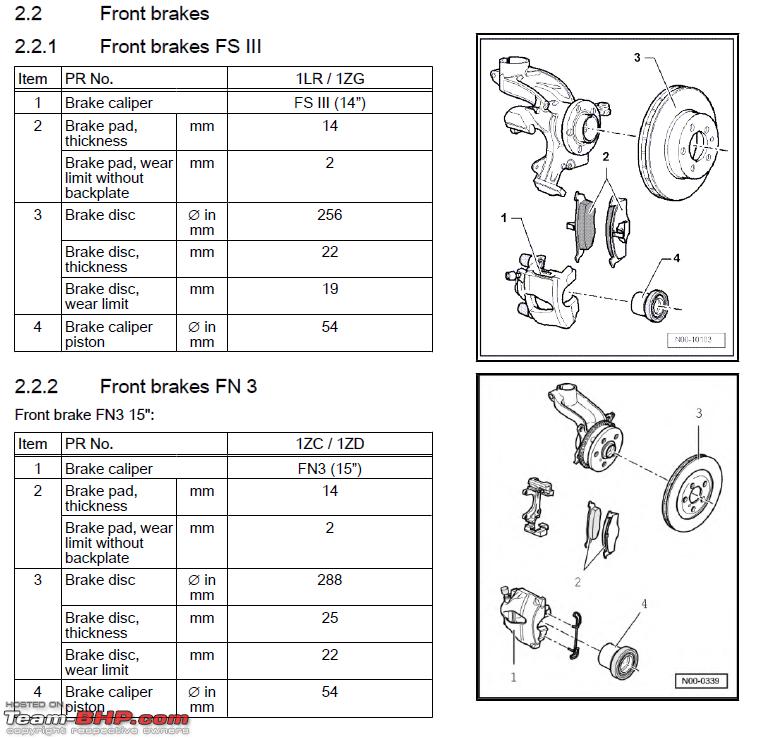
I have therefore hand-tightened all the bolts. I have mentioned the torque values for reference wherever available for those who prefer to use the torque wrench.
Parts required: - Brake discs - 6RF 615 301A
- Brake pad set - 6RU 698 151B
- Brake pad service kit - 6RU 698 647A
Consumables required: - Brake grease (also supplied with the service kit in a sachet)
- Brake cleaner spray
- WD40
- 220 grit dry sandpaper x 1
Procedure:
Slacken the lug bolts of the front wheels, jack up the front, place jack stands below the strong points and remove the wheels. Keep the wheels below the running boards for additional safety.
Wear a face mask. Clean the caliper assembly with the wire brush and brake cleaner spray.


With a wire brush, this may take a while and can be a bit exhausting. If you have a drill, get a cup brush attachment and use it (in breaks/intervals to avoid the drill getting overheated).
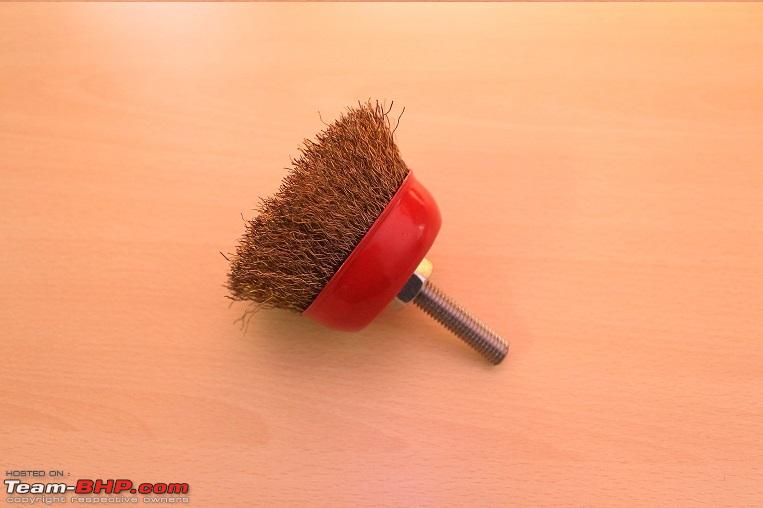
Use the 12 mm socket to remove the two caliper holding down bolts.
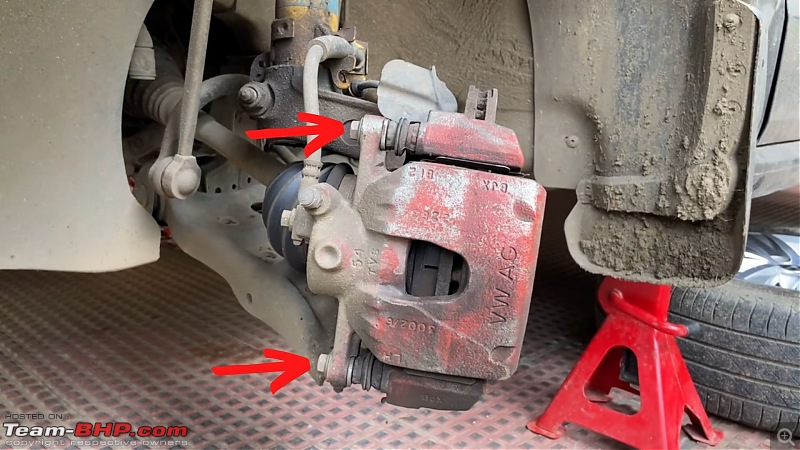
These bolts are to be discarded since we will be using new bolts from the service kit. For now, place the bolts in the magnetic screw tray. (I dont throw away the old bolts unless the head is rounded or the threads are worn out).

Remove the caliper and hang it using the S-hook/hanger taking support from the spring of the strut assembly.

Never leave the caliper hanging under its own weight as it exerts undue pressure on the hydraulic brake hose.
Slide the brake pads out of the metal shims.

If they are old and worn out, they have to be replaced. If they have the sintered frictional material left (at least 4-6 mm; wear limit as per VWs workshop manual is 2 mm), the pads can be reused (as I did during this service).
Pull the guide pins out of the caliper bracket assembly along with the rubber cap.

This can be a bit hard depending on the condition of the grease inside. If the grease has dried up or has become mucky, the pin would have become tight. In such cases, use a plier to pull the pin out. Older guide pins have to be discarded and renewed.
Use an 18 mm socket or 18-19 ring spanner to unscrew the two caliper bracket bolts.

Remove the caliper bracket from the assembly.

Keep these bolts safe as they will be reused.
Use a T30 torx bit from the 1/4 ratchet kit to unscrew the rotor/disc from the hub:

Keep the Torx screw safe.
Remove the two metal shims from the caliper bracket and clean the caliper bracket thoroughly using the wire brush (or the drill + cup brush attachment) and brake cleaner spray.
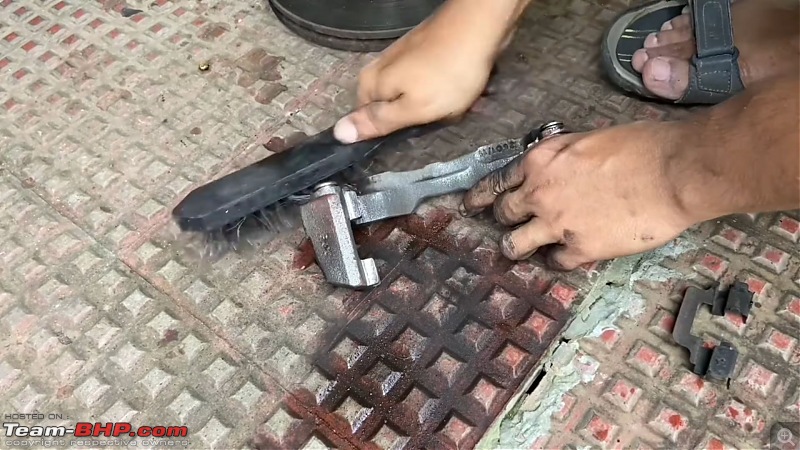
Clean the guide pin holes on the caliper bracket.
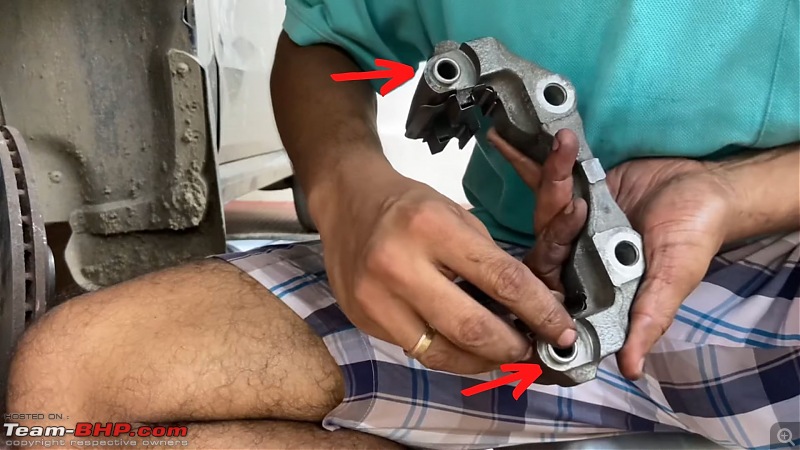
A straw cleaning brush works best. These brushes have smaller bristles and can access the smallest holes like the ones in lab pipettes.

Clean the two metal shims thoroughly for any grease/muck.
If the rotors have sufficient thickness of the cast iron material left, they can be reused. When the brake pads are renewed, it is advisable to have them resurfaced or machined to remove the scoring marks before reusing them. This prevents juddering and excessive vibrations while braking especially at high speeds.
Measure the thickness of the rotors using a vernier caliper or screw gauge.

If the thickness is at least 20-21 mm, you can reuse the rotors after resurfacing or machining them on a lathe at a lathe workshop. There are special brake lathes meant for this purpose installed in some workshops which moves the tool post automatically from the inside to outside.
Here's one such brake lathe at an engineering workshop:


Some workshops may not however and the operator manually moves the tool post outwards after mounting the rotor on the chuck and centering it. Like the one below:

If the thickness of the rotors fall short of the limit (19 mm), it is advised not to renew them and must be replaced with new rotors.
The thickness of the rotors on my car measured 21.xx mm and I had them resurfaced at a lathe workshop.
Before:
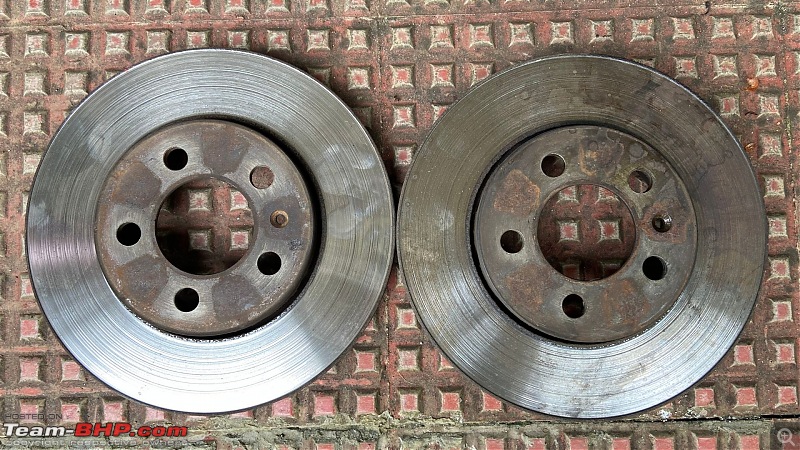

After:


Clean the wheel hub for any surface rust.

I have seen anti-seize copper grease being applied on the hubs after they are cleaned. I prefer not to grease the hubs and keep it clean just like they were from the factory.

Clean the brake dust shield with brake cleaner spray and cloth.
Mount the resurfaced (or replacement) rotor to the hub and secure it with the Torx T30 screw.

The ETKA manual gives a tightening torque of
4.5 Nm. I have hand tightened it.
Mount the caliper bracket to the hub using the two hex bolts.

Use the 18 mm socket or 18-19 ring spanner to tighten the hex bolts.
 124 Nm
124 Nm is the torque value indicated for the 288 mm discs meant for the 15 FN3 system. Since I couldnt get the values for the 256 mm discs installed, I preferred to hand tighten them.
Open the cap of the brake fluid reservoir cap to permit the fluid to rise when the caliper piston is compressed. Spread some cloth around the mouth of the reservoir, just in case fluid overflows.

Next up, compress the caliper piston to its stock position to permit the brake pads to be set in place in the caliper. The easiest way to do this is to use a 150 mm/6 C-clamp along with the old brake pad to compress the caliper piston to its stock position.

During the last time, we had to resort to a screwdriver and use all our might to push the piston - this was clearly time consuming and exhausting!
Close the cap of the brake fluid reservoir after both the pistons are compressed. Clean any brake fluid which may have overflown and check the level of the brake fluid in the reservoir. It should be above the minimum mark - top up if necessary with the correct grade of fluid (DOT 3/4 etc).
Clean the mating surface of the piston with a cloth and brake cleaner spray.

[*]Grease the guide ways in the metal shims.

Clean any grease from the rotors later with the brake cleaner spray and a cloth.
Insert the brake pads into the caliper bracket.
Very important - pay attention to the
INSIDE and
OUTSIDE markings on the brake pads if the rivets on the backplate are located at different positions.

Some pads may not have it this way however (as shown below) and will have the rivets located at the extreme outer ends. In such cases, the pads can be used in any side.
 (Image courtesy - Boodmo)
(Image courtesy - Boodmo)
Apply some grease on the mating surface of the backplate of the pads.

Grease the new caliper pins and insert them into the guide pin holes of the caliper bracket.
 Important
Important - Pay attention to the pins as they are not interchangeable. One of them has a rubber sleeve and can be inserted only on the top guide pin hole of the bracket.
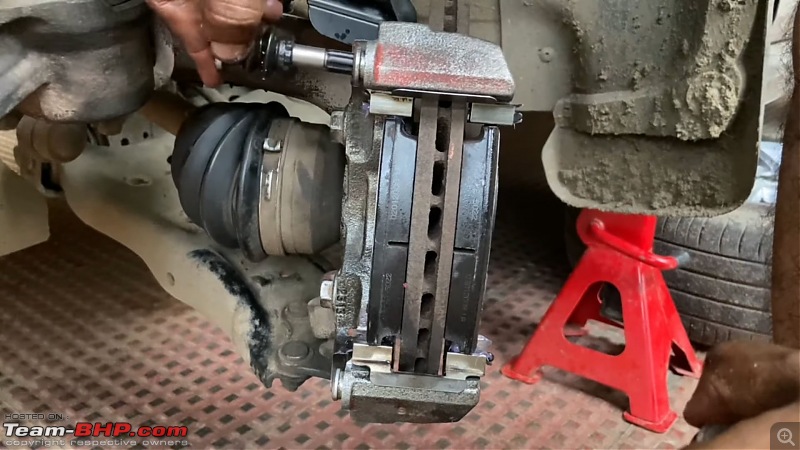
The pin should be able to slide in and out effortlessly - check this aspect. Remove any excess grease.
Insert the caliper in place and secure it using the new holding down bolts.


The job is complete.

Replace the wheel back, secure the lug nuts, lower the car to the ground from the jack stands and tighten the lug nuts by hand.
Take a test drive to assess the braking performance.
Important - Before driving off, depress the brake pedal several times to ensure that the piston presses against the brake pads. The pedal play decreases as you depress it 3-4 times.
For those who find videos convenient, heres the link:
Ill take up the 2-man brake bleeding job shortly and share the process and findings here.
Trust this was useful. Let me know if you have any queries or feedback.

 (49)
Thanks
(49)
Thanks

 (2)
Thanks
(2)
Thanks
 (7)
Thanks
(7)
Thanks

 (2)
Thanks
(2)
Thanks
 (3)
Thanks
(3)
Thanks
 (1)
Thanks
(1)
Thanks
 (6)
Thanks
(6)
Thanks
 (1)
Thanks
(1)
Thanks
 (1)
Thanks
(1)
Thanks
 (1)
Thanks
(1)
Thanks

 (6)
Thanks
(6)
Thanks






















































